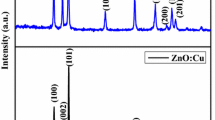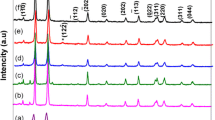Abstract
A facile one-step co-precipitation method used to fabricate the nanocrystalline CuO nanoparticles and Ce-doped CuO nanoparticles at different pH, i.e. 10 and 12. Determination of structural and optical properties was done using X-Ray diffraction, FT-IR and UV–Visible spectroscopic methods. The sharp XRD pattern of CuO nanoparticles confirmed its crystalline nature and monoclinic structure. The crystalline size of pure CuO nanoparticles was around 21.04 nm at pH 10 which reduced to 15.14 nm on doing of 5% Ce. At pH 12, the crystalline size of pure CuO nanoparticles and Ce-doped CuO nanoparticles was less in comparison to pH 10 as estimated from Debye–Scherrer formula. FT-IR spectra further confirmed the formation of CuO nanoparticles and the absorption band at 852 and 650 cm−1 confirmed the presence of CeO2 in the monoclinic phase of CuO nanoparticles. From UV–Vis absorption measurement, the optical band gap and maximum absorption wavelength were determined, and it was observed that both these quantities depend on the pH value as well as Ce metal concentration. Band gap value increased on increasing the dopant concentration which might be due to the Burstein–Moss (BM) effect. The paper presents a study of pH and dopant concentration variation for Ce-doped CuO nanoparticles with tunable particle size and tunable bandgap along with improved structural, optical and thermal properties.





Similar content being viewed by others
Data availability
The datasets generated during and/or analysed during the current study are available from the corresponding author on reasonable request.
References
P.K. Sharma, S. Dorlikar, P. Rawat, V. Malik, N. Vats, M. Sharma, J.S. Rhyee, A.K. Kaushik, Nanotechnology and its application: a review. Nanotechnol. Cancer Manage. (2021). https://doi.org/10.1016/B978-0-12-818154-6.00010-X
R. Ahmad, N. Tripathy, M.-S. Ahn, K.S. Bhat, T. Mahmoudi, Y. Wang et al., Highly efficient non-enzymatic glucose sensor based on CuO modified vertically-grown ZnO nanorods on electrode. Sci. Rep. 7, 5715 (2017). https://doi.org/10.1038/s41598-017-06064-8
P. Leangtanom, A. Wisitsoraat, K. Jaruwongrangsee, N. Chanlek, A. Tuantranont, S. Phanichphant, V. Kruefu, Highly sensitive and selective sensing of H2S gas using precipitation and impregnation-made CuO/SnO2 thick films. Nanoscale. Res. Lett. 16, 70 (2021). https://doi.org/10.1186/s11671-021-03530-1
P. Cea, The high temperature superconductivity in cuprates: physics of the pseudogap region. Eur. Phys. J. B 89, 176 (2016). https://doi.org/10.1140/epjb/e2016-70259-3
S. Tada, F. Watanabe, K. Kiyota, N. Shimoda, R. Hayashi, M. Takahashi et al., Ag addition to CuO–ZrO2 catalysts promotes methanol synthesis via CO2 hydrogenation. J. Catal. 351, 107–118 (2017). https://doi.org/10.1016/j.jcat.2017.04.021
L. Hao, Y. Zhang, R. Kubomura, S. Ozeki, S. Liu, H. Yoshida, Y. Jin, Y. Lu, Preparation and thermoelectric properties of CuAlO2 compacts by tape casting followed by SPS. J. Alloys Compd. 853, 157086 (2021). https://doi.org/10.1016/j.jallcom.2020.157086
A.K. Mishra, A.K. Nayak, A.K. Das, D. Pradhan, Microwave-assisted solvothermal synthesis of cupric oxide nanostructures for high-performance supercapacitor. J Phys Chem. C 122, 11249–11261 (2018). https://doi.org/10.1021/acs.jpcc.8b02210
H. Siddiqui, M.R. Parra, P. Pandey, M.S. Qureshi, F.Z. Haque, Utility of copper oxide nanoparticles (CuO-NPs) as efficient electron donor material in bulk-heterojunction solar cells with enhanced power conversion efficiency. J. Sci. Adv. Mater. Dev. 5(1), 104–110 (2020). https://doi.org/10.1016/j.jsamd.2020.01.004
S. Jayakodi, V.K. Shanmugam, Green synthesis of CuO nanoparticles and its application on toxicology evaluation. Biointerface Res. Appl. Chem. 10(5), 6343–6353 (2020). https://doi.org/10.33263/BRIAC105.63436353
A.A. Gvozdenko, S.A. Siddiqui, A.V. Blinov et al., Synthesis of CuO nanoparticles stabilized with gelatin for potential use in food packaging applications. Sci. Rep. 12, 12843 (2022). https://doi.org/10.1038/s41598-022-16878-w
A.V. Blinov, A.A. Gvozdenko, M.A. Yasnaya, A.A. Blinova, A.A. Kravtsov, S.O. Krandievsky. Synthesing and studying the structure of nanoscale copper (II) oxide stabilized by polyethylene glycol. Phys. Technol. Nanostruct. Nuclear Mol. Phys. (2020) https://doi.org/10.18698/1812-3368-2020-3-56-70.
S. Steinhauer, Gas sensors based on copper oxide nanomaterials: a review. Chemosensors 9, 51 (2021). https://doi.org/10.3390/chemosensors9030051
I.M.A. Hasan, K.M. Abd-Elsabur, F.H. Assaf et al., Folic acid determination in food samples using green synthesized copper oxide nanoparticles and electro-poly(methyl orange) sensor. Electrocatalysis 13, 759–772 (2022). https://doi.org/10.1007/s12678-022-00756-0
F. Pino, C.C.M. Mayorga, A. Merkoçi, High-performance sensor based on copper oxide nanoparticles for dual detection of phenolic compounds and a pesticide. Electrochem. Commun. (2016). https://doi.org/10.1016/j.elecom.2016.08.001
A. Kumar, A. Choudhary, H. Kaur et al., Metal-based nanoparticles, sensors, and their multifaceted application in food packaging. J. Nanobiotechnol. 19, 256 (2021). https://doi.org/10.1186/s12951-021-00996-0
C. Thangamani, M. Ponnar, P. Priyadharshini, P. Monisha, S. Gomathi, K. Pushpanathan, Magnetic behavior of Ni-doped CuO nanoparticles synthesized by microwave irradiation method. Surf. Rev. Lett. (2018). https://doi.org/10.1142/s0218625x18501846
M. Ponnar, C. Thangamani, P. Monisha, S.S. Gomathi, K. Pushpanathan, Influence of Ce doping on CuO nanoparticles synthesized by microwave irradiation method. Appl. Surf. Sci. 449, 132–143 (2018). https://doi.org/10.1016/j.apsusc.01.126
T. Shahid, M. Arfan, W. Ahmad, T. BiBi, T. Khan, Synthesis and doping feasibility of composite-hydroxide-mediated approach for the Cu1-xZnxO nanomaterials. Adv. Mater. Lett. 7, 561–566 (2016). https://doi.org/10.5185/amlett.2016.6384
M. Arfan, D.N. Siddiqui, T. Shahid, Z. Iqbal, Y. Majeed, I. Akram et al., Tailoring of nanostructures: Al doped CuO synthesized by composite-hydroxide-mediated approach. Results Phys. 13, 102187 (2019). https://doi.org/10.1016/j.rinp.2019.102187
D. Renuga, J. Jeyasundari, A.S.S. Athithan, Y.B.A. Jacob, Synthesis and characterization of copper oxide nanoparticles using Brassica oleracea var. italic extract for its antifungal application. Mater. Res. Expr. 7, 045007 (2020). https://doi.org/10.1088/2053-1591/ab7b94
A.E. Nogueira, A.S. Giroto, A.B.S. Neto, C. Ribeiro, CuO synthesized by solvothermal method as a high capacity adsorbent for hexavalent chromium. Colloids Surf A. 498, 161–167 (2016). https://doi.org/10.1016/j.colsurfa.2016.03.022
A. Mahmood, A. Haseeb, S. Rozali, D. Brabazon, B.M.A. Rahman, K.T.V. Grattan, S. Naher, Synthesis of ZnO and cuo nanowires by thermal oxidation on metallic substrates. Key Eng. Mater. 926, 1703–1712 (2022). https://doi.org/10.4028/p-qvfxm2
N. Silva, S. Ramírez, I. Díaz, A. Garcia, N. Hassan, Easy, quick, and reproducible sonochemical synthesis of CuO nanoparticles. Materials (Basel) 12, 804 (2019). https://doi.org/10.3390/ma12050804
W.M. Rangel, R.A. Antunes Boca Santa, H.G. Riella, A facile method for synthesis of nanostructured copper (II) oxide by coprecipitation. J. Mater. Res. Technol. 9, 994–1004 (2020). https://doi.org/10.1016/j.jmrt.2019.11.039
P. Kankanit, S. Sineenart, M. Wanichaya, P. Wisanu, Synthesis of CuO Nanoparticles by precipitation method using different precursors. Energy Proc. 34, 740–745 (2013). https://doi.org/10.1016/j.egypro.2013.06.808
S.H. Lafta, Effect of pH on structural, magnetic and FMR properties of hydrothermally prepared nano Ni ferrite. Open Chem. 15, 53–60 (2017). https://doi.org/10.1515/chem-2017-0007
R. Rajamma, S. Gopalakrishnan, F. Abdul Khadar, B. Baskaran, Antibacterial and anticancer activity of biosynthesised CuO nanoparticles. IET Nanobiotechnol. 14, 833–838 (2020). https://doi.org/10.1049/iet-nbt.2020.0088
M. Bayat, M. Zargar, E. Chudinova, T. Astarkhanova, E. Pakina, In vitro evaluation of antibacterial and antifungal activity of biogenic silver and copper nanoparticles: the first report of applying biogenic nanoparticles against pilidium concavum and Pestalotia sp. Fungi Mol. 26, 5402 (2021). https://doi.org/10.3390/molecules26175402
S.J. Singh, P. Chinnamuthu, Highly efficient natural-sunlight-driven photodegradation of organic dyes with combustion derived Ce-doped CuO nanoparticles. Colloids Surf. A Physicochem. Eng. Aspects 625, 126864 (2021). https://doi.org/10.1016/j.colsurfa.2021.126864
S. Velliyan, V. Rajendran, Study on the effect of Ce3+ doping on structural, morphological and optical properties of CuO nanoparticles synthesized via combustion technique. Phys. B Condensed Matter 613, 413015 (2021). https://doi.org/10.1016/j.physb.2021.413015
C. Benjamine, M. Abdur Rahman, Structural, morphological and optical properties of Ce doped CuO nanoparticles prepared by co precipitation method. JETIR 5, 11 (2018)
M.R. Islam, M. Saiduzzaman, S.S. Nishat, A. Kabir, S.F.U. Farhad, Synthesis, characterization and visible light-responsive photocatalysis properties of Ce doped CuO nanoparticles: a combined experimental and DFT+U study. Colloids Surf. A Physicochem. Eng. Aspects. 617, 126386 (2021). https://doi.org/10.1016/j.colsurfa.2021.126386
Z.J. Ren, A.K. Umble, Water treatment: recover wastewater resources locally. Nature 529, 316–325 (2016)
A. Raees, M.A. Jamal, I. Ahmed, M. Silanpaa, Algarni, Synthesis and characterization of CeO2/CuO nanocomposites for photocatalytic degradation of methylene blue in visible light. Coating. 11, 305 (2021). https://doi.org/10.3390/coatings11030305
J. Singh, V. Kumar, K.H. Kim, M. Rawat, Biogenic synthesis of copper oxide nanoparticles using plant extract and its prodigious potential for photocatalytic degradation of dyes. Environ. Res. 177, 108569 (2019). https://doi.org/10.1016/j.envres.2019.108569
Acknowledgements
Authors gratefully thankful to K R Mangalam University, Gurugram for the financial support and University of Delhi for technical support.
Funding
Authors have no funding from any source.
Author information
Authors and Affiliations
Corresponding author
Ethics declarations
Conflict of interest
The authors declare that there is no conflict of interest.
Additional information
Publisher's Note
Springer Nature remains neutral with regard to jurisdictional claims in published maps and institutional affiliations.
Rights and permissions
Springer Nature or its licensor (e.g. a society or other partner) holds exclusive rights to this article under a publishing agreement with the author(s) or other rightsholder(s); author self-archiving of the accepted manuscript version of this article is solely governed by the terms of such publishing agreement and applicable law.
About this article
Cite this article
Abhilasha, Kumari, N. & Gautam, R. Investigation of impact of pH and rare earth metal dopant concentration on structural, optical and thermal properties of CuO nanoparticles. Appl. Phys. A 129, 64 (2023). https://doi.org/10.1007/s00339-022-06355-6
Received:
Accepted:
Published:
DOI: https://doi.org/10.1007/s00339-022-06355-6




